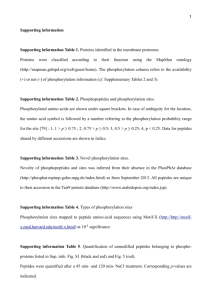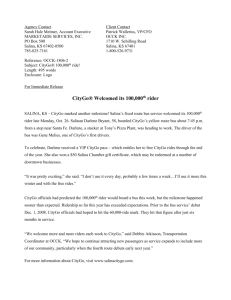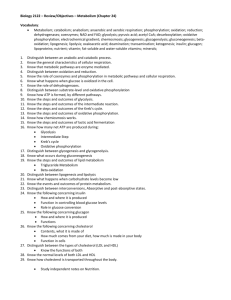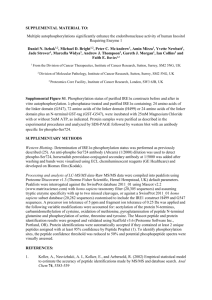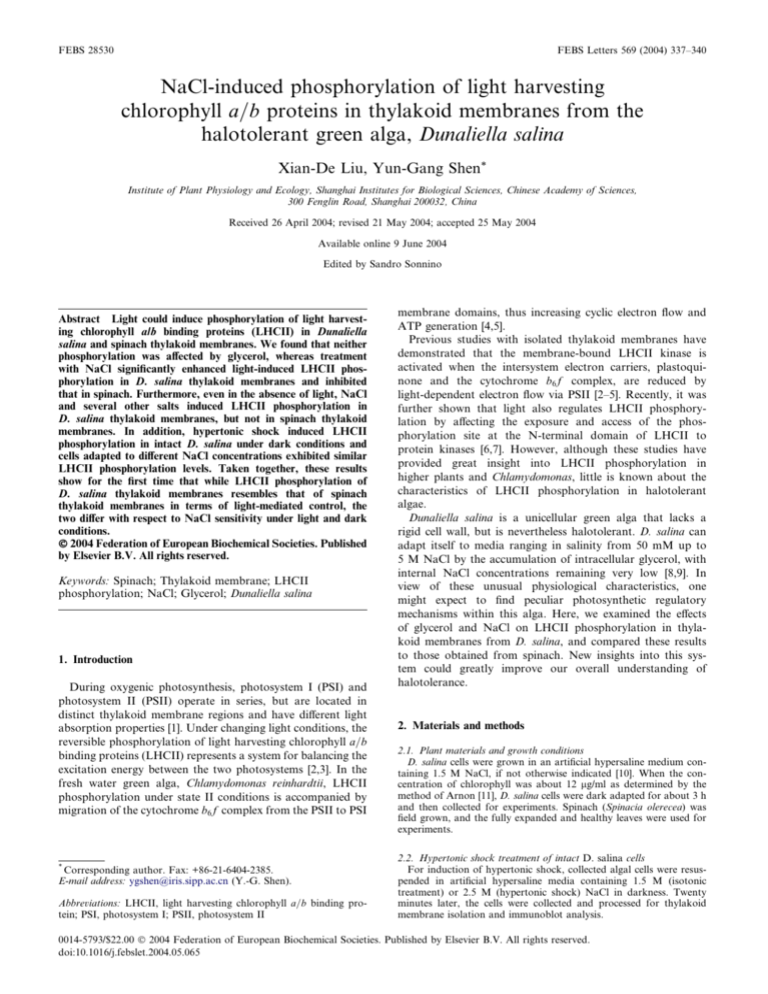
FEBS 28530
FEBS Letters 569 (2004) 337–340
NaCl-induced phosphorylation of light harvesting
chlorophyll a=b proteins in thylakoid membranes from the
halotolerant green alga, Dunaliella salina
Xian-De Liu, Yun-Gang Shen*
Institute of Plant Physiology and Ecology, Shanghai Institutes for Biological Sciences, Chinese Academy of Sciences,
300 Fenglin Road, Shanghai 200032, China
Received 26 April 2004; revised 21 May 2004; accepted 25 May 2004
Available online 9 June 2004
Edited by Sandro Sonnino
Abstract Light could induce phosphorylation of light harvesting chlorophyll a/b binding proteins (LHCII) in Dunaliella
salina and spinach thylakoid membranes. We found that neither
phosphorylation was affected by glycerol, whereas treatment
with NaCl significantly enhanced light-induced LHCII phosphorylation in D. salina thylakoid membranes and inhibited
that in spinach. Furthermore, even in the absence of light, NaCl
and several other salts induced LHCII phosphorylation in
D. salina thylakoid membranes, but not in spinach thylakoid
membranes. In addition, hypertonic shock induced LHCII
phosphorylation in intact D. salina under dark conditions and
cells adapted to different NaCl concentrations exhibited similar
LHCII phosphorylation levels. Taken together, these results
show for the first time that while LHCII phosphorylation of
D. salina thylakoid membranes resembles that of spinach
thylakoid membranes in terms of light-mediated control, the
two differ with respect to NaCl sensitivity under light and dark
conditions.
Ó 2004 Federation of European Biochemical Societies. Published
by Elsevier B.V. All rights reserved.
Keywords: Spinach; Thylakoid membrane; LHCII
phosphorylation; NaCl; Glycerol; Dunaliella salina
1. Introduction
During oxygenic photosynthesis, photosystem I (PSI) and
photosystem II (PSII) operate in series, but are located in
distinct thylakoid membrane regions and have different light
absorption properties [1]. Under changing light conditions, the
reversible phosphorylation of light harvesting chlorophyll a=b
binding proteins (LHCII) represents a system for balancing the
excitation energy between the two photosystems [2,3]. In the
fresh water green alga, Chlamydomonas reinhardtii, LHCII
phosphorylation under state II conditions is accompanied by
migration of the cytochrome b6 f complex from the PSII to PSI
*
Corresponding author. Fax: +86-21-6404-2385.
E-mail address: ygshen@iris.sipp.ac.cn (Y.-G. Shen).
Abbreviations: LHCII, light harvesting chlorophyll a=b binding protein; PSI, photosystem I; PSII, photosystem II
membrane domains, thus increasing cyclic electron flow and
ATP generation [4,5].
Previous studies with isolated thylakoid membranes have
demonstrated that the membrane-bound LHCII kinase is
activated when the intersystem electron carriers, plastoquinone and the cytochrome b6 f complex, are reduced by
light-dependent electron flow via PSII [2–5]. Recently, it was
further shown that light also regulates LHCII phosphorylation by affecting the exposure and access of the phosphorylation site at the N-terminal domain of LHCII to
protein kinases [6,7]. However, although these studies have
provided great insight into LHCII phosphorylation in
higher plants and Chlamydomonas, little is known about the
characteristics of LHCII phosphorylation in halotolerant
algae.
Dunaliella salina is a unicellular green alga that lacks a
rigid cell wall, but is nevertheless halotolerant. D. salina can
adapt itself to media ranging in salinity from 50 mM up to
5 M NaCl by the accumulation of intracellular glycerol, with
internal NaCl concentrations remaining very low [8,9]. In
view of these unusual physiological characteristics, one
might expect to find peculiar photosynthetic regulatory
mechanisms within this alga. Here, we examined the effects
of glycerol and NaCl on LHCII phosphorylation in thylakoid membranes from D. salina, and compared these results
to those obtained from spinach. New insights into this system could greatly improve our overall understanding of
halotolerance.
2. Materials and methods
2.1. Plant materials and growth conditions
D. salina cells were grown in an artificial hypersaline medium containing 1.5 M NaCl, if not otherwise indicated [10]. When the concentration of chlorophyll was about 12 lg/ml as determined by the
method of Arnon [11], D. salina cells were dark adapted for about 3 h
and then collected for experiments. Spinach (Spinacia olerecea) was
field grown, and the fully expanded and healthy leaves were used for
experiments.
2.2. Hypertonic shock treatment of intact D. salina cells
For induction of hypertonic shock, collected algal cells were resuspended in artificial hypersaline media containing 1.5 M (isotonic
treatment) or 2.5 M (hypertonic shock) NaCl in darkness. Twenty
minutes later, the cells were collected and processed for thylakoid
membrane isolation and immunoblot analysis.
0014-5793/$22.00 Ó 2004 Federation of European Biochemical Societies. Published by Elsevier B.V. All rights reserved.
doi:10.1016/j.febslet.2004.05.065
338
2.3. Phosphorylation of thylakoid proteins in vitro
Thylakoid membranes were isolated according to the method of
Kim et al. [12]. The collected dark-adapted D. salina cells were
suspended with sonication buffer (100 mM Tris–HCl, pH 6.8, 5 mM
MgCl2 , 0.2% polyvinyl pyrrolidone K30, 3 mM aminocaproic acid,
1 mM aminobenzamidine and 0.2 mM phenylmethanesulfonyl
fluoride) and then disrupted by sonication for 90 s. Spinach leaves
were disrupted in sonication buffer with a Waring Blender and the
slurry was filtered through four layers of cheesecloth. Unbroken
cells and other large fragments were removed by centrifugation at
3000 g for 3 min at 4 °C. To avoid the aggregation of thylakoid
membranes and to maintain the activity of LHCII kinase, the thylakoid membrane-containing supernatant (less than 0.5 ml) was diluted to 50 lg chlorophyll/ml with 20 ml phosphorylation reaction
medium (50 mM Tris–HCl, pH 8.0, 10 mM MgCl2 , 10 mM NaF
and 400 lM ATP) for experimental phosphorylation of the thylakoid proteins [13]. These mixtures were incubated for 20 min at 25
°C in the presence or absence of glycerol, NaCl or other salts under
either dark or light (about 200 lmol photons m2 s1 ) conditions.
Samples were then centrifuged at 40 000 g for 20 min at 4 °C and
the pellets were resuspended in sonication buffer to 1 mg chlorophyll/ml.
2.4. Thylakoid membrane protein analysis and immunoblotting
The isolated D. salina or spinach thylakoid membranes were solubilized in 0.5 M Tris–HCl (pH 6.8), 7% SDS, 20% glycerol and 2 M
urea, and then incubated at 50 °C for 30 min. Unsolubilized materials were removed by centrifugation at 3000 g for 5 min [12].
Thylakoid membrane proteins were resolved by SDS–PAGE (15%
acrylamide, 0.5% bisacrylamide and 4 M urea [12]) using 0.75 6 8
cm slabs on the miniprotein three cell system (Bio-Rad). Each sample
contains 2.5 lg chlorophyll. The separated polypeptides were stained
with 0.1% Coomassie Brilliant Blue R or electrophoretically transferred to HybondTM ECLTM nitrocellulose membrane (Amersham
Pharmacia) with a semi-dry transfer cell (Amersham Pharmacia) for
immunoblot analysis. Phosphorylated thylakoid membrane proteins
were detected with rabbit polyclonal phosphothreonine (Thr (P))
antibody (Zymed), since all the main PSII core phosphoproteins and
LHCII proteins are known to be phosphorylated at an N-terminus
threonine residue [14].
X.-D. Liu, Y.-G. Shen / FEBS Letters 569 (2004) 337–340
brane polypeptides, and the approximate position of LHCII
indicated according to the results of Kim et al. [12]. As can
be seen in Fig. 1B, light induced phosphorylation of two 29
kD phosphoproteins in D. salina thylakoid membranes.
Based on the phosphorylation patterns reported for other
green algae [15–17], we identified these as LHCII apoproteins. It is possible that the phosphorylated LHCII phosphoproteins seen in dark-adapted thylakoid membranes
might represent the phosphorylation level present in situ
prior to their isolation; some LHCII phosphoproteins were
found to be phosphorylated in dark-adapted D. salina cells
[10], probably due to the partial reduction of the PQ pool by
chlororespiration in darkness in green algae [18]. In fact, no
dark LHCII phosphorylation activity was found in D. salina
thylakoid membranes in the presence of ATP alone in
phosphorylation medium (data not shown). Light also induced LHCII phosphorylation in spinach thylakoid membranes. At the same time, increased phosphorylation of the
D1 reaction center protein, which occurs only in seed plants
[19], was observed following light stimuli in spinach thylakoid
membranes (Fig. 1C).
3.2. Glycerol does not affect light-induced LHCII
phosphorylation in D. salina or spinach thylakoid
membranes
Glycerol, the compatible solute of Dunaliella, accumulates
internally in these cells under physiological growth conditions
[8,9]. Finel et al. [20] reported that glycerol stimulated cyclic
photophosphorylation catalyzed by D. bardawil thylakoid
membranes, but inhibited that catalyzed by spinach thylakoid
membranes. Here, we found that light-induced LHCII phosphorylation was not significantly affected by the presence of
glycerol (10%, 20%, 30%) in D. salina (Fig. 2A) or spinach
(Fig. 2B) thylakoid membranes, even though glycerol does not
accumulate in spinach cells.
3. Results
3.1. Light induces LHCII phosphorylation in D. salina and
spinach thylakoid membranes
Fig. 1A shows the SDS–PAGE profiles of Coomassiestained dark-adapted D. salina and spinach thylakoid mem-
Fig. 1. Profile of Coomassie-stained dark-adapted D. salina (MBD ) and
spinach thylakoid membranes (MBS ) (A) and light-induced LHCII
phosphorylation in D. salina thylakoid membranes (B) and in spinach
thylakoid membranes (C). Thylakoid membrane proteins from darkadapted D. salina or spinach were phosphorylated at 25 °C for 20 min
either in the dark (D) or in the light (about 200 lmol photons m2 s1 )
(L). The positions of phosphorylated LHCII and D1 protein recognized by the Thr (P) antibody are indicated.
3.3. NaCl stimulates light-induced LHCII phosphorylation in
D. salina thylakoid membranes and inhibits that in spinach
thylakoid membranes
Interestingly, we found that LHCII phosphorylation levels
in light-stimulated D. salina thylakoid membranes were enhanced by the presence of increasing concentrations of NaCl
(0.1, 0.2 or 0.3 M) in the protein phosphorylation reaction
medium (Fig. 3A). In contrast, light-induced LHCII phos-
Fig. 2. Glycerol does not affect light-induced LHCII phosphorylation
in D. salina thylakoid membranes (A) or in spinach thylakoid membranes (B). Thylakoid membrane proteins from dark-adapted D. salina
or spinach were phosphorylated 25 °C for 20 min either in the dark
(CD ), or in the light (about 200 lmol photons m2 s1 ) in the absence
(CL ) or in the presence of the indicated glycerol concentrations. The
positions of phosphorylated LHCII and D1 protein recognized by the
Thr (P) antibody are indicated.
X.-D. Liu, Y.-G. Shen / FEBS Letters 569 (2004) 337–340
339
phorylation decreased in spinach thylakoid membranes in the
presence of NaCl (Fig. 3B). Proteolysis of LHCII in spinach
thylakoid membranes is known to require an induction period
of at least 48 h after transfer of the plants from low-intensity to
high-intensity light [21]. Thus, the observed decrease in lightinduced LHCII phosphorylation under our experimental
conditions may be related to the inhibitory effects of NaCl
rather than LHCII degradation.
3.4. In the dark, NaCl induces LHCII phosphorylation in
D. salina thylakoid membranes but not in spinach
thylakoid membranes
Notably, addition of NaCl to dark-adapted D. salina thylakoid membranes caused an increase in LHCII phosphorylation levels (Fig. 4A), and light had an additive effect on
NaCl-induced LHCII phosphorylation. Fig. 4B further shows
that treatment with 0.3 M LiCl, KCl, MgCl2 , CaCl2 or NaNO3
also induced LHCII phosphorylation in D. salina thylakoid
membranes in darkness. However, the presence of glycerol at
equivalent osmotic concentrations to 0.3 M NaCl (0.55 Os/kg
[22]) had no effect on LHCII phosphorylation in the dark
(Fig. 4B). In contrast, while LHCII phosphorylation still could
be induced by light in the presence of 0.3 M NaCl, no NaClinduced phosphorylation was observed in spinach thylakoid
membranes under dark conditions (Fig. 4C).
3.5. Hypertonic shock induces LHCII phosphorylation in
darkness in intact D. salina cells
Since there is influx of Naþ and Kþ [23] into alga when D.
salina suffers hypertonic shock, we further studied the salt-induced LHCII phosphorylation in darkness by investigating the
changes in LHCII phosphorylation in intact D. salina cells
under such stress condition. Compared with isotonically
treated D. salina cells (external NaCl concentration unchanged
at 1.5 M), hypertonically shocked D. salina cells (external
NaCl concentration increased from 1.5 to 2.5 M) showed
higher LHCII phosphorylation levels (Fig. 5A). However,
dark-adapted D. salina cells grown in media containing 1.5 or
2.5 M NaCl exhibited similar LHCII phosphorylation levels
(Fig. 5B). These results indicate that LHCII phosphorylation
might be a response to internal NaCl concentration increases
following hypertonic shock, instead of being associated with
consistently elevated external salt concentrations.
Fig. 3. NaCl stimulates light-induced phosphorylation of LHCII in D.
salina thylakoid membranes (A), but inhibits that in spinach thylakoid
membranes (B). Thylakoid membrane proteins from dark-adapted D.
salina or spinach were phosphorylated at 25 °C for 20 min either in the
dark (CD ), or in the light (about 200 lmol photons m2 s1 ) in the
absence (CL ) or in the presence of the indicated NaCl concentrations.
The positions of phosphorylated LHCII and D1 protein recognized by
the Thr (P) antibody are indicated.
Fig. 4. NaCl and other salts induce LHCII phosphorylation in darkadapted D. salina thylakoid membranes (A and B) but not in spinach
thylakoid membranes (C). Thylakoid membrane proteins from darkadapted D. salina or spinach were phosphorylated at 25 °C for 20 min
in darkness in the absence (CD ) or presence of the indicated concentrations of NaCl or other salts, or in the light (about 200 lmol photons
m2 s1 ) in the presence of 0.3 M NaCl (0.3 (L)). The positions of
phosphorylated LHCII and D1 protein recognized by the Thr (P)
antibody are indicated.
Fig. 5. Hypertonic shock induces LHCII phosphorylation in intact D.
salina cells (A), whereas D. salina cells grown in medium containing
different NaCl concentrations exhibit similar LHCII phosphorylation
levels (B). I1:5–1:5 M and H1:5–2:5 M represent LHCII phosphorylation
levels in D. salina cells grown isotonically (external NaCl concentration
consistent at 1.5 M) and hypertonically (external NaCl concentrations
increased from 1.5 to 2.5 M), respectively. S1:5 M and S2:5 M represent
steady LHCII phosphorylation levels in dark-adapted D. salina cells
grown in media containing 1.5 and 2.5 M NaCl, respectively. The
positions of phosphorylated LHCII recognized by the Thr (P) antibody are indicated.
4. Discussion
Here, we showed that light induced LHCII phosphorylation
in thylakoid membranes from D. salina and spinach, and that
neither phosphorylation event was significantly affected by
glycerol. These results indicate that LHCII phosphorylation in
D. salina resembles that of spinach in terms of light-mediated
control.
A number of studies with isolated thylakoid membranes
from higher plants have revealed that thylakoid membrane
protein phosphorylation in vitro is light-dependent [2,3,24–27].
Vener et al. [13,28] reported that dark phosphorylation was
induced by low pH in spinach thylakoid membranes. Here, we
found that NaCl induced LHCII phosphorylation in D. salina
thylakoid membranes in the dark (Fig. 3A), but not in spinach
thylakoid membranes (Fig. 3C). Furthermore, LHCII phosphorylation of D. salina membranes reacted similarly to
comparable treatments with LiCl, KCl, NaNO3 and other
salts, whereas glycerol had no effect. Thus, it may be ions rather than hyperosmosis that mediate NaCl-induced LHCII
340
phosphorylation. While further work will be required to fully
test this possibility, our experiments showed that neither inhibitors of the cytochrome b6 f complex reduction nor oxidizing agents had inhibitory effects on NaCl-induced LHCII
phosphorylation in D. salina thylakoid membranes (unpublished data). Together, these results indicate that salt has different effects on LHCII phosphorylation of D. salina than do
light and low pH. A detailed analysis of this issue will be
presented in a future report.
Light is known to induce LHCII phosphorylation via both
activation of LHCII kinase and exposure of the LHCII
phosphorylation site [3,6,7]. Here, our result showed that NaCl
also induced LHCII phosphorylation in the dark in D. salina
thylakoid membranes (Fig. 4A). In this case, NaCl may
stimulate light-induced activation of the relevant protein kinase and/or induce conformational changes in LHCII, leading
to additive effects on light-induced LHCII phosphorylation
(Figs. 3A and 4A). In contrast, our results indicate that NaCl
exerts opposite effects in spinach thylakoid membranes, effectively inhibiting light-induced LHCII phosphorylation
(Fig. 3B).
Previous studies have shown that NaCl exerted inhibitory
effects on the activities of Dunaliella thylakoid membrane
ATPases and some soluble Dunaliella enzymes [20,29–31]. This
is consistent with the notion that Dunaliella cells contain high
glycerol and low internal salt concentrations under growth
conditions with high external NaCl concentrations [8,9,23].
However, our results showed that NaCl stimulated LHCII
phosphorylation in D. salina thylakoid membranes under both
light and dark conditions (Figs. 3A and 4A). Thus, the NaClinduced LHCII phosphorylation in D. salina is expected to act
as an adaptation mechanism when the internal salt concentrations increase. This hypothesis was further confirmed by our
observation that hypertonic shock induced LHCII phosphorylation in D. salina cells (Fig. 5).
In C. reinhardtii, depression of mitochondrial ATP synthesis
in the presence of uncouplers or ATP synthase inhibitors induced state II transitions associated with LHCII phosphorylation; this reorganization of the photosynthetic apparatus
favors cyclic electron flow and ATP generation [4,5,32,33]. In
D. salina cells, we found that similar treatments also caused
LHCII phosphorylation (unpublished data) and that NaCl
and other salts induced LHCII phosphorylation. These results
suggest that in D. salina cells exposed to hypertonic shock, not
only does the ATP content decrease [34,35] but also an ion
influx is likely to induce LHCII phosphorylation and a subsequent state I–state II transition. In this way, the halotolerant
green alga could enhance ATP synthesis to contribute to
glycerol synthesis and Naþ extrusion [27,36]. This hypothesis is
supported by previous observations of changes in chlorophyll
fluorescence, which suggested that cyclic electron flow was
enhanced under these conditions [36].
Acknowledgements: The authors thank professor Jia-Mian Wei for
critical comments on the manuscript. This work was supported by the
X.-D. Liu, Y.-G. Shen / FEBS Letters 569 (2004) 337–340
State Key Basic
G1998010100).
Development
Plan
Program
(Grant
No.
References
[1] Anderson, J.M. (1999) Aust. J. Plant Physiol. 26, 625–639.
[2] Allen, J.F. (1992) Biochim. Biophys. Acta 1098, 275–335.
[3] Aro, E.M. and Ohad, I. (2003) Antioxid. Redox Signal. 5, 55–
67.
[4] Wollman, F.A. (2001) EMBO J. 14, 3623–3630.
[5] Rochaix, J.D. (2002) FEBS Lett. 529, 34–38.
[6] Zer, H., Vink, M., Keren, N., Dilly-Hartwig, H.G., Paulsen, H.,
Herrmann, R.G., Andersson, B. and Ohad, I. (1999) Proc. Natl.
Acad. Sci. USA 96, 8277–8282.
[7] Zer, H., Vink, M., Shochat, S., Herrmann, R.G., Andersson, B.
and Ohad, I. (2003) Biochemistry 42, 728–738.
[8] Ben-Amotz, A. and Avron, M. (1973) Plant Physiol. 51, 875–878.
[9] Pick, U., Karni, L. and Avron, M. (1986) Plant Physiol. 81, 92–96.
[10] Liu, X.D. and Shen, Y.G. (2004) Chin. Sci. Bull. 49, 672–675.
[11] Arnon, D.I. (1949) Plant Physiol. 24, 1–15.
[12] Kim, J.H., Nemson, J.A. and Melis, A. (1993) Plant Physiol. 103,
181–189.
[13] Vener, A.V., van Kan, P.J.M., Gal, A., Andersson, B. and Ohad,
I. (1995) J. Biol. Chem. 270, 25225–25232.
[14] Rintam€aki, E., Salonen, M., Suoranta, U.M., Carlberg, I.,
Andersson, B. and Aro, E.M. (1997) J. Biol. Chem. 272, 30476–
30482.
[15] Owens, G.C. and Ohad, I. (1982) J. Cell Biol. 93, 712–718.
[16] Wollman, F.A. and Delepelaire, P. (1984) J. Cell Biol. 98, 1–7.
[17] Morgan-Kiss, R., Ivanov, A.G. and Huner, N.P.A. (2002) Planta
214, 435–445.
[18] Bennoun, P. (1982) Proc. Natl. Acad. Sci. USA 79, 4352–4356.
[19] Pursiheimo, S., Rintam€aki, E., Baena-Gonzalez, E. and Aro, E.M.
(1998) FEBS Lett. 423, 178–182.
[20] Finel, M., Pick, U., Selman-Reimer, S. and Selman, B.R. (1984)
Plant Physiol. 74, 766–772.
[21] Lindahl, M., Yang, D.H. and Andersson, B. (1995) Eur. J.
Biochem. 231, 503–509.
[22] Meijer, H.J.G., Arisz, S.A., van Himbergen, J.A.J., Musgrave, A.
and Munnik, T. (2001) Plant J. 25, 541–548.
[23] Ehrenfeld, J. and Cousin, J.L. (1984) J. Membrane Biol. 77, 45–
55.
[24] Bennett, J. (1979) FEBS Lett. 103, 342–344.
[25] Beliveau, R. and Bellemare, G. (1979) Biochem. Biophys. Res.
Commun. 88, 797–803.
[26] Allen, J.F. and Bennett, J. (1981) FEBS Lett. 123, 67–70.
[27] Allen, J.F., Bennett, J., Steinback, K.E. and Arntzen, C.J. (1981)
Nature 291, 25–29.
[28] Vener, A.V., van Kan, P.J.M., Rich, P.R., Ohad, I. and
Andersson, B. (1997) Proc. Natl. Acad. Sci. USA 94, 1585–1590.
[29] Borowitzka, L.J. and Brown, A.D. (1974) Arch. Microbiol. 72,
37–52.
[30] Ben-Amotz, A. (1975) J. Phycol. 11, 50–54.
[31] Marengo, T., Lilley, R.McC. and Brown, A.D. (1985) Arch.
Microbiol. 142, 262–268.
[32] Delepelaire, P. and Wollman, F.A. (1985) Biochim. Biophys. Acta
809, 277–283.
[33] Bulte, L., Gans, P., Rebeille, F. and Wollman, F.A. (1990)
Biochim. Biophys. Acta 1020, 72–80.
[34] Goyal, A., Brown, A.D. and Lilley, R.M. (1988) Biochim.
Biophys. Acta 936, 20–28.
[35] Bental, M., Pick, U., Avron, M. and Degani, H. (1990) Eur. J.
Biochem. 188, 111–116.
[36] Gilmour, D.J., Hipkins, M.F., Webber, A.N., Baker, N.R. and
Boney, A.D. (1985) Planta 163, 250–256.

